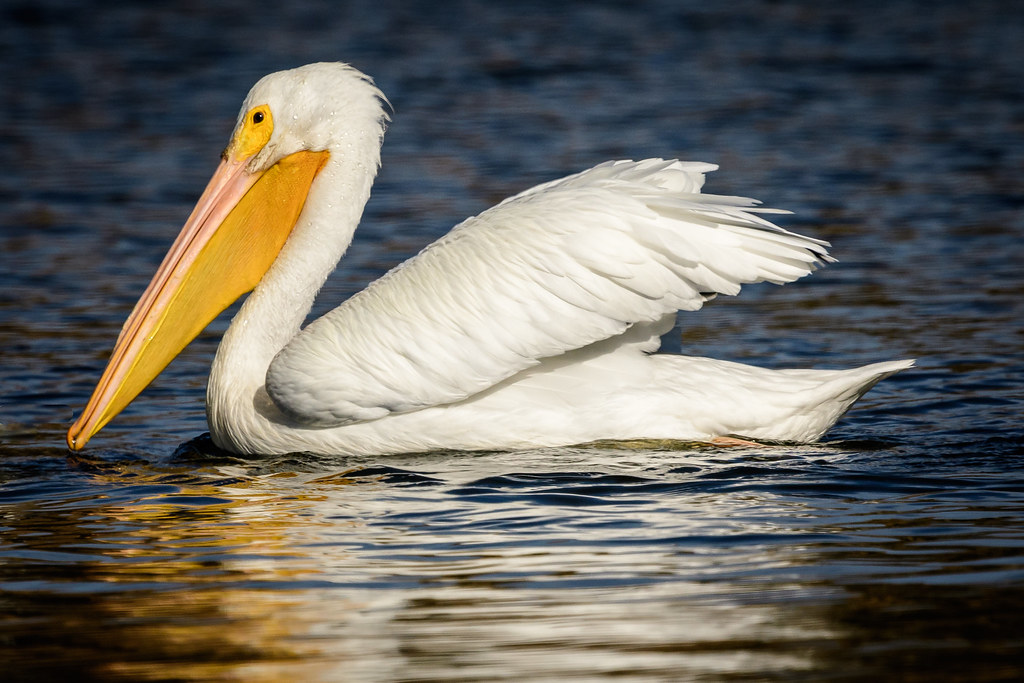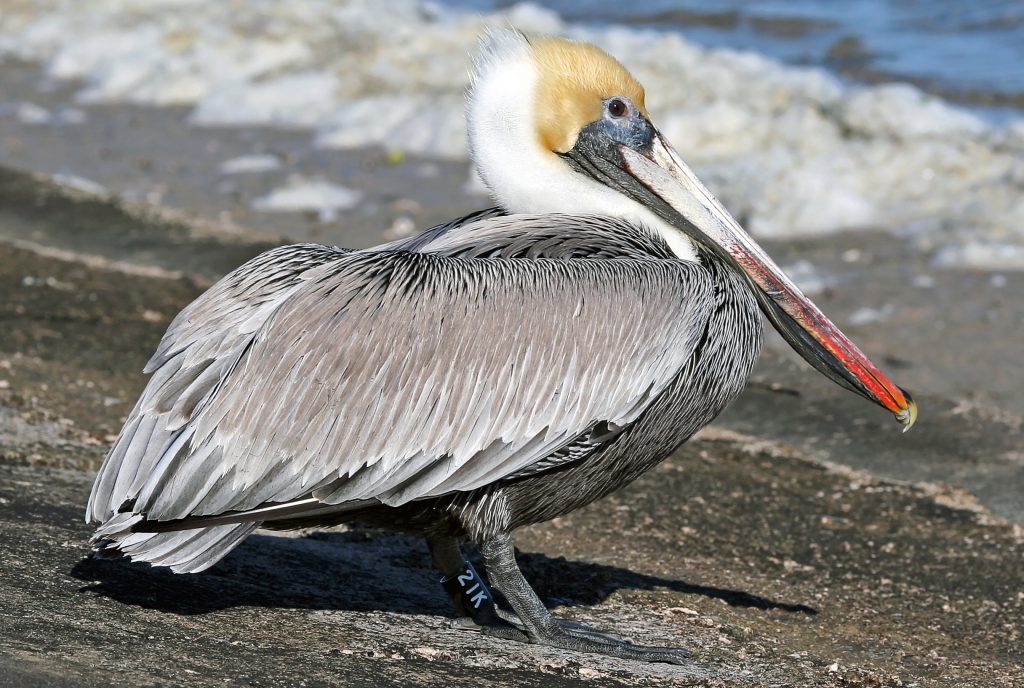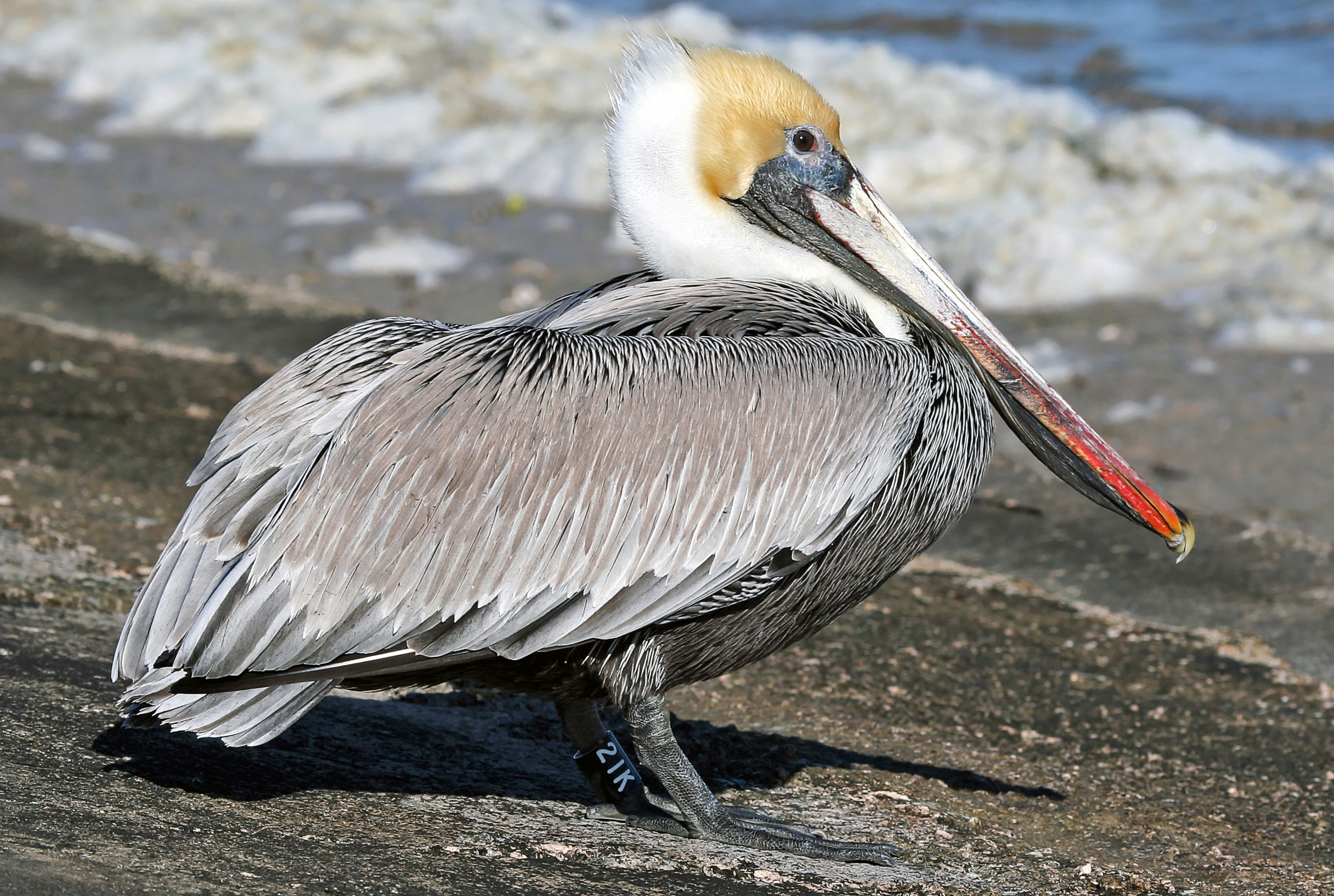Wyoming is home to both species of Pelican found in North America. These magnificent birds, the American White Pelican and the Brown Pelican, can be observed in the state. While the American White Pelican frequents Wyoming during the summer months, the presence of Brown Pelicans is rare and sporadic.
Pelicans are renowned for their imposing size and distinctive features such as their enormous bills, expandable throat pouches, and sturdy feet. Despite their considerable bulk, they possess a surprising lightness due to air pockets present in their skeleton and skin, aiding buoyancy. Additionally, their elongated wings enable graceful soaring during flight.
Globally, there are eight species of pelicans, two of which reside in North America: the American White Pelican and the Brown Pelican.
During the breeding season, pelicans undergo fascinating transformations. Their facial skin, throats, and bills become adorned with vibrant hues, while some develop extra structures on their bills.
Pelicans engage in colony breeding, with colonies consisting of up to an impressive 50,000 individuals. Nesting habits vary among species, with some opting for ground nests while others choose trees. After approximately 25 days of nurturing in the nest, young pelicans gather in “creches” composed of up to 100 chicks. Remarkably, parents can distinguish their own offspring and solely provide sustenance to their kin.
Despite their predatory nature, pelicans do not fall under the category of birds of prey, which is reserved for raptors. Their diet primarily comprises fish, although they also consume crabs, frogs, snakes, small mammals, birds, and insects.
When hunting fish, pelicans employ their expansive throat pouches to capture their quarry, subsequently draining water before ingestion. Juvenile pelicans, on the other hand, receive nourishment directly from their parents’ pouches.
To aid bird enthusiasts in identifying the Pelicans inhabiting Wyoming, this guide draws upon avibase and data gathered by avid bird watchers on ebird. It offers genuine information concerning the presence of these birds in the region.
Wyoming is graced with the presence of two Pelican species:
American White Pelican

The American White Pelican predominantly visits Wyoming during the summer season, generally from April to November, although a few individuals may be sighted throughout the year. Approximately 9% of summer checklists submitted by bird watchers in the state record the American White Pelican’s presence.
Distinguished by their impressive wingspan, American White Pelicans rank among the largest birds in North America. Adult non-breeding individuals display an entirely white plumage, with black flight feathers visible during flight or when their wings are extended. They possess bluish-gray eyes and exhibit yellow facial skin surrounding their eyes. Pale orange bills, pouches, and feet further characterize these magnificent birds. Juveniles exhibit light gray feathers with darker brown napes.
During the breeding season, adult American White Pelicans undergo distinct color changes. They develop a yellow plate akin to a horn on their upper bills. While their bodies remain white, their bills, as well as the skin around their eyes, legs, and feet, transition to a vibrant orange hue.
American White Pelicans experience molting changes, known as eclipse. In spring, a noticeable yellowish patch appears on their breast and chest. During summer, their heads acquire blackish feathers.
- Pelecanus erythrorhynchos
- Length: 60 – 63 inches (152 – 160 cm)
- Weight: 246.4 ounces (6983 g)
- Wingspan: 96 – 110 inches (244 – 279 cm)
Before wintering along the southern Pacific Coast of the United States, the Gulf of Mexico, Mexico, and Central America, American White Pelicans breed in remote inland lakes throughout
North America. During migration, these magnificent birds can be observed in various western and central states of the US.
American White Pelicans prefer habitats encompassing shallow freshwater lakes, wetlands, and the edges of lakes and rivers. In winter, they venture into coastal bays, inlets, and estuaries, where they forage in shallow water and seek respite on sandbars.
Their diet primarily consists of fish. American White Pelicans skillfully swim on the water’s surface, capturing prey within their colossal bills. Additionally, they engage in cooperative foraging with other birds, employing a coordinated strategy to drive fish toward the shore, optimizing their feeding efficiency.
These opportunistic birds relentlessly pursue food sources, venturing considerable distances in search of superior feeding grounds. Furthermore, they display a propensity for pilfering fish from the water’s surface, snatching them away from unsuspecting avian counterparts.
The vocalizations of American White Pelicans are generally limited to infrequent grunts, with adults typically maintaining silence. However, the young pelicans can become quite raucous within the vast colonies as they vocalize their hunger.
American White Pelican nests consist of simple, shallow depressions on the ground. Twigs, sticks, reeds, and other materials are accumulated to provide protection for the eggs.
The female lays one to two eggs, which are diligently incubated by both parents for approximately thirty-six days. Unfortunately, due to a phenomenon known as siblicide, in which one sibling kills the other, only one chick typically survives per nest.
Fascinating Fact: The long and prodigious bill of the American White Pelican possesses the remarkable capacity to hold up to three gallons of water. When hunting, these birds tilt their bills downward, allowing water to drain away, leaving behind the fish to be swallowed from their throat sacs.
Brown Pelican

Spotting a Brown Pelican in Wyoming is a rarity, as they have been recognized by the Wyoming Bird Records Committee as rare or accidental species within the state.
Non-breeding adult Brown Pelicans exhibit white heads and necks with pale yellow foreheads. Their lengthy bills display a combination of yellow and orange hues. Their bodies feature grayish-brown plumage, complemented by short black legs and webbed feet. Juveniles display brown heads, necks, backs, and wings, with bluish-gray bills and a light brown underside.
The Brown Pelican comprises five subspecies, two of which breed within the United States: P.o.californicus along the Pacific Coast and P.o.carolinensis along the Atlantic Coast.
During the breeding season, notable differences emerge between Pacific and Atlantic Brown Pelicans. Both species exhibit white heads with vibrant yellow foreheads. However, their napes transition from white to dark brown. Atlantic Brown Pelicans possess olive-brown throat pouches, whereas Pacific Brown Pelicans display red skin within their pouches.
- Pelecanus occidentalis
- Length: 48 – 50 inches (122 – 127 cm)
- Weight: 131.2 ounces (3718 g)
- Wingspan: 78 – 84 inches (198 – 213 cm)
Brown Pelicans either breed, migrate, or remain resident year-round along the Pacific and Atlantic Coasts of North America, extending to northern South America.
These birds can be found in proximity to shallow water environments, inhabiting estuaries, coastal marine habitats, mangrove islets, as well as resting on sandbars, breakwaters, and offshore rocks.
Distinguishing themselves with a unique foraging technique, Brown Pelicans plunge into the depths of the ocean to capture prey within their expandable throat pouches. Upon resurfacing, they expel water, promptly swallowing their catch.
The primary component of their diet is fish, such as sardines and herring. When not engaged in diving, Brown Pelicans leisurely swim, seizing prey with their bills. Additionally, they demonstrate a willingness to consume crustaceans, amphibians, eggs, and young birds.
Adult Brown Pelicans are generally quiet, emitting only occasional grunts, while juveniles vocalize to beseech food.
Brown Pelicans construct nests more commonly on the ground, rather than in trees. Islands, mangroves, and cliffs serve as concealment and protection for these nests. Female pelicans adeptly build nests using reeds, leaves, pebbles, sticks, and soil. Each nest typically harbors two to four eggs, which are diligently incubated by both parents for approximately a month.
Fascinating Fact: Brown Pelicans employ their webbed feet to cover and incubate their eggs. This nurturing behavior, while endearing, inadvertently threatened the species in the past due to the pesticide DDT, which resulted in the thinning of eggshells, causing them to break under the weight of their parents’ feet. Extensive conservation efforts were necessary to restore Brown Pelican populations.
